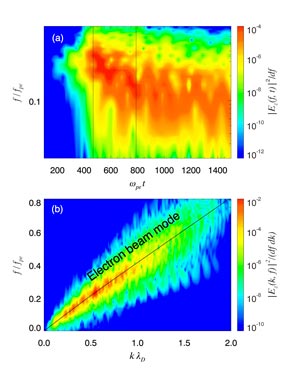2012 ARTEMIS SCIENCE NUGGETS
Kinetic instabilities in the lunar wake: ARTEMIS observations
by Jianbao Tao, UC Berkeley Space Sciences Laboratory
Introduction
The ARTEMIS P1 spacecraft provided interesting observations of the lunar wake from its first lunar-wake flyby in early 2010. One particularly interesting aspect of this flyby is that it provided high-resolution electric field instrument (EFI) measurements of electrostatic waves observed during the flyby that are due to kinetic instabilities, which enables us to derive wavelength and phase velocity using interferometric techniques. This paper provides such analyses, as well as 1D Vlasov simulations of the observed kinetic instabilities.
Results
Figure 1 illustrates a wave series bypassing an EFI boom on a spinning spacecraft. From this picture, one can derive interferometric relations between phase shift and wavenumber, and those between time delay and phase velocity.
| Figure 1. Schematic illustration of waves bypassing an EFI boom. The two blue balls represent two opposite EFI sensors of the EFI boom aboard a spacecraft with a spinning rate ωs. The red curve represents a wave series bypassing the spacecraft. |
The derived interferometric relations can be used to derive wavenumber and phase velocities using high-resolution voltage measurements from EFI. Figure 2 shows an example of such analysis. For high-coherence (~1) signals, the theoretical values of phase shift and time delay follow the observations remarkably well, as shown in Figures 2(b) and 2(c).
| Figure 2. An example of the interferometric analyses. From top to bottom, the three panels show coherence, phase shift, and time delay between the two time-series signals from two opposite EFI sensors. The black lines are from the observations, whereas the red lines are based on theoretic relations for the signals. |
In addition to wavelength and phase velocity, the wave mode is another important piece of information about the observed electrostatic waves. Figure 3 shows 1D Vlasov simulation results for the observed electrostatic waves. The results suggest that the observed electrostatic waves are likely on the electron beam mode branch.
| Figure 3. An example of the Vlasov simulations of the observed electrostatic waves. The top panel shows a frequency-time spectrum from the simulation, and the bottom panel a frequency-wavenumber spectrum. |
Conclusion
This paper shows the characteristics of the observed electrostatic waves during the first lunar-wake flyby of ARTEMIS P1, in particular, the wavelength and phase velocity measurements from interferometric analyses of EFI data. The estimated wavelengths vary from a few hundred meters to a couple of thousand meters, whereas the estimated phase velocities are on the order of 1000 km/s. Additionally, 1D Vlasov simulations suggest that these waves were likely the electron beam mode.
Reference
Tao, J. B., et al. (2012), Kinetic instabilities in the lunar wake: ARTEMIS observations, J. Geophys. Res., 117, A03106, doi:10.1029/2011JA017364.Biographical Note
Jianbao Tao is a postdoctoral researcher at the Space Sciences Laboratory, University of California at Berkeley. His recent interests include 1) statistical features of intense Poynting flux and turbulent E and B fields in the terrestrial magnetotail observed by THEMIS, 2) electron phase-space holes, double layers, and their roles in space plasmas, 3) kinetic waves in the lunar plasma environment, and 4) particle accelerations in the Earth’s radiation belts.
 Please send comments/suggestions to
Emmanuel Masongsong / emasongsong@igpp.ucla.edu
Please send comments/suggestions to
Emmanuel Masongsong / emasongsong@igpp.ucla.edu


